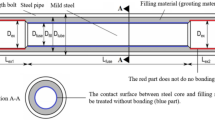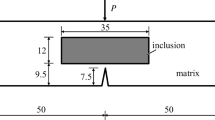The modern problems of tribotechnical material science are considered; in particular, the selforganization in polymer composites has been studied. It is established that steady-state selective transfer reduces the wear rate of an epoxy composite material. It is confirmed that it can be used in partial or zero lubrication conditions. The self-organization processes that occur in polymer composites during tribological interaction determine the suitability of a system to be used as a selflubricating material. In friction, the determining factor is not only the initial material structure, but also the surface layer structure formed according to the load–speed operating mode.





Similar content being viewed by others
References
V. F. Labunets, L. S. Bratitsa, T. S. Klimova, and N. A. Medvedeva, “Materials science—basis for development of modern tribological engineering,” in: M. V. Kindrachuk (ed.), Problems of Friction and Wear: Collected Scientific Papers [in Ukrainian], Issue 53 (2010), pp. 34–41.
A. G. Kostornov, Tribotechnical Materials Science: Monograph [in Russian], Knowledge, Donetsk (2012), p. 696.
M. V. Kindrachuk, V. F. Labunets, M. I. Pashechko, and E. V. Korbut, Tribology: Course Book [in Ukrainian], NAU-Druk, Kyiv (2009), p. 392.
A. L. Zaitsev and P. V. Sysoev, “On friction interaction of some polymer materials with hardmetal,” Tren. Iznos, 8, No. 2, 348–353 (1987).
V. V. Zolotoreva, V. A. Lipskaya, and Yu. S. Kochergin, “Studying the wear of epoxy materials,” in: Proc. 25th Int. Sci. Conf., Science, Engineering, Technology [in Ukrainian], Kyiv (2005), pp. 312–314.
Yu. S. Lipatov, Physicochemical Fundamentals of Polymer Reinforcement [in Russian], Khimiya, Moscow (1991), p. 260.
P. N. Bogdanovich and V. N. Belov, “Thermal processes in the contact zone of friction bodies,” Tren. Iznos, 13, No. 4, 624–632 (1992).
V. I. Myshko and Ya. V. Kochetova, “Studying the wear resistance of copper-reinforced polymer composites,” Kompoz. Polim. Mater., No. 9, 12–18 (1981).
L. M. Denisov, Sliding Bearings with Wearless Friction. Tribonics: Course Book [in Russian], Irkutsk. Politekh. Inst., Irkutsk (1982), p. 88.
P. P. Savchuk and A. G. Kostornov, “Properties of epoxy composites for tribotechnical applications,” Problems of Friction and Wear: Collected Scientific Papers [in Ukrainian], Issue 49, 52–60 (2008).
P. P. Savchuk and A. G. Kostornov, “Patterns for controlling the structure and properties of protective epoxy composites,” Fiz. Khim. Mekh. Mater., Special Issue 7 (Problems of Corrosion and Corrosion Protection of Materials), 453–456 (2008).
A. G. Kostornov and P. P. Savchuk, “Production of epoxy composites with controlled properties,” in: Proc. 5th Int. Conf. Materials and Coatings in Extreme Conditions: Study, Application, and Environmentally Friendly Technologies for Production and Disposal of Parts [in Russian] (September 22–26, Kyiv), Kyiv (2008), p. 28.
O. L. Sadova, “Self-organization phenomenon in surface layers of epoxy composites in friction interaction,” Nauk. Notat., Issue 47, 166–171 (2014).
O. L. Sadova, V. P. Kashitsky, and P. P. Savchuk, “Formation of self-organized structures in surface layers of tribological parts,” Visn. Prykarpatsk. Nats. Univ. Vasylya Stefanyka. Ser. Khim., Issue 19, 13–23 (2015).
Author information
Authors and Affiliations
Corresponding author
Additional information
Translated from Poroshkovaya Metallurgiya, Vol. 56, Nos. 7–8 (516), pp. 111–120, 2017.
Rights and permissions
About this article
Cite this article
Savchuk, P.P., Kashytsky, V.P., Sadova, O.L. et al. Structural Transformations on the Surfaces of Epoxy Composite–Steel Tribological Pair. Powder Metall Met Ceram 56, 448–455 (2017). https://doi.org/10.1007/s11106-017-9915-3
Received:
Published:
Issue Date:
DOI: https://doi.org/10.1007/s11106-017-9915-3




